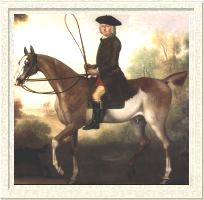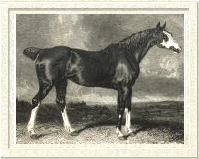|
|
Was Skewball a Skewbald?

|
|
| A skewbald or piebald in 18th century Great Britain seems to have been any horse with broad splashes of white in any size and any pattern, what we would call a "Pinto" today. The first volume of the General Studbook (1793) lists several horses with the color noted as "pyebald," or "roan or pyebald." Later the terms were differentiated, a piebald used to define a horse marked like a black and white "Pinto," and "skewbald" marked with white and any color other than black. Today, these color patterns are more specifically defined, based on pattern and extent of the white markings. The tendency to spot can be present in solid-color parents, perhaps for generations, and suddenly "crop out" in a foal. This happens, although rarely, in many breeds, including thoroughbreds.
|

Viscount Gage on His Roan/Piebald Hunter, 1743 by James Seymour

Miss Turner, a half-bred famous trotting mare,
c. 1830 | |
Today, it's generally recognized that the Sabino pattern of spotting is fairly common in thoroughbreds, most often in one of its minimal expressions, of a wide blaze and tall stockings. In some cases the white extends above the knees and hocks, and the blaze can take on wide and wild patterns. Occasionally such horses will have large or small splashes of white on their bellies and elsewhere.
Nineteenth century turf writers occasionally noted that skewbalds, piebalds, and duns were "previously seen" on the racecourses of Great Britain, but that they had all but disappeared. As mentioned previously, the first volume of the General Stud Book does include horses of the color "pyebald," one of whom, Rantipole (1769, by Blank - sister to Careless by Regulus) had a daughter, whose color was listed as chestnut, but who was named Skewball (1786, by Tandem). In the 19th century, the roan-colored Rapid Rhone (1860, by Young Melbourne) won the Claret Stakes at Newmarket. His granddam, Physalis (1841, by Bay Middleton), had a daughter who produced piebald twins.
Viscount Gage's hunter to the left is an example of what today would be called a roan-sabino. Miss Turner is a more frequently seen example of a horse with sabino markings. |
Skewball is listed in the General Stud Book as a bay. He is also listed in Pond's Racing Calendaras a bay. His sire, the Godolphin Arabian, was a bay with minimal white socks below his fetlock joints. His maternal grandsire, (Godolphin's) Whitefoot was bay, although he probably had at least one white leg, given his name. We do not know the color and markings of his dam, Bandy.
On the other hand, Skewball's name does imply he was a skewbald. As noted previously, a later filly named Skewball was listed in the General Stud Book as chestnut but was from a "roan/pyebald" mare, and it seems likely she, at least, was splashed with notable white markings. It's entirely possible that the bay Skewball was likewise splashed with white. The 19th century writer Samuel Sidney includes a note about Skewball in his discussion about piebalds. Unfortunately, our primary account of the famous match, the various versions of the Skewball ballads, fails to mention his color--unless, he was, in fact, a skewbald.
--Patricia Erigero
|
|
|

